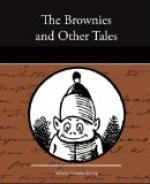of the back streets. For most of the houses were
small, and most of them were painted white, and back
streets ran parallel with each other, and had no names,
and were all so much alike that it was very confusing.
For instance, if you had asked the way to Mr. So-and-So’s,
it is very probable that some friend would have directed
you as follows: “Go straight forward and
take the first turning to your left, and you will
find that there are four streets, which run at right
angles to the one you are in, and parallel with each
other. Each of them has got a big pine in it—one
of the old forest trees. Take the last street
but one, and the fifth white house you come to is Mr.
So-and-So’s. He has green blinds and a coloured
servant.” You would not always have got
such clear directions as these, but with them you would
probably have found the house at last, partly by accident,
partly by the blinds and coloured servant. Some
of the neighbours affirmed that the little white house
had a name; that all the houses and streets had names,
only they were traditional and not recorded anywhere;
that very few people knew them, and nobody made any
use of them. The name of the little white house
was said to be Trafalgar Villa, which seemed so inappropriate
to the modest peaceful little home, that the man who
lived in it tried to find out why it had been so called.
He thought that his predecessor must have been in
the navy, until he found that he had been the owner
of what is called a “dry-goods store,”
which seems to mean a shop where things are sold which
are not good to eat or drink—such as drapery.
At last somebody said, that as there was a public-house
called the “Duke of Wellington” at the
corner of the street, there probably had been a nearer
one called “The Nelson,” which had been
burnt down, and that the man who built “The
Nelson” had built the house with the spruce fir
before it, and that so the name had arisen. An
explanation which was just so far probable, that public-houses
and fires were of frequent occurrence in those parts.
But this has nothing to do with the story. Only
we must say, as we said before, and as we should have
said had we been living there then, the child we speak
of lived in the little white house with one spruce
fir just in front of it.
Of all the children who looked forward to the Christmas
tree, he looked forward to it the most intensely.
He was an imaginative child, of a simple, happy nature,
easy to please. His father was an Englishman,
and in the long winter evenings he would tell the
child tales of the old country, to which his mother
would listen also. Perhaps the parents enjoyed
these stories the most. To the boy they were new,
and consequently delightful, but to the parents they
were old; and as regards some stories, that is better
still.
“What kind of a bird is this on my letter?”
asked the boy on the day which brought the Governor’s
lady’s note of invitation. “And oh!
what is a Christmas tree?”




